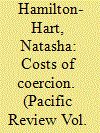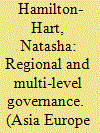|
|
|
Sort Order |
|
|
|
Items / Page
|
|
|
|
|
|
|
| Srl | Item |
| 1 |
ID:
120205


|
|
|
|
|
| Publication |
2013.
|
| Summary/Abstract |
Violent conflict tends to be costly overall, but can, under some conditions, yield net gains for the initiators of violence, thus creating incentives for coercion. This article explores the economic incentives for coercion across three different arenas and types of conflict: international conflict among states, organized political violence within the state, and relatively unorganized domestic conflicts over property rights. Although these conflicts are normally studied in separate scholarly traditions (respectively, international relations, domestic security studies and political economy), drawing from these different traditions can help explain the comparative incidence of coercive force in different conflict arenas by identifying conditions that create incentives for violence. Using cases from Southeast Asia, the article offers an explanation for the empirical pattern of violence in the region being more prevalent currently at the domestic, rather than the international, level and most pervasive in apparently low-level and unorganized forms. At least in part, this pattern is a consequence of the relative stability and consistent protection of what may be thought of as international property rights claims, compared with the greater uncertainty and inconsistency in the enforcement of domestic rights claims. While intuitively paradoxical when viewed through Westphalian lenses, which assume international anarchy and domestic hierarchy, greater contention over domestic rights claims is consistent with the relative asymmetries in coercive capabilities and institutions for dealing with rights claims at the domestic level, compared with the international arena.
|
|
|
|
|
|
|
|
|
|
|
|
|
|
|
|
| 2 |
ID:
160538


|
|
|
|
|
| Summary/Abstract |
Indonesia’s banks and financial markets have developed considerably over the twenty years following the country’s devastating financial crisis of 1997–98. Government policy has balanced a variety of objectives involving the financial sector, such as seeking growth, financial inclusion, and stability. Recent data shows that financial stability indicators are mostly robust, suggesting a relatively resilient banking sector. Also, interventionist policies under the government of President Joko Widodo, aimed at promoting financial inclusion and growth, have so far not been excessively costly. However, a degree of inefficiency may be the price to pay for financial stability. This article explores some of the policy and structural sources of inefficiency in the banking sector as they have developed over recent years. It shows that Indonesia’s banking sector is structurally segmented, with limited competition among the largest banks and a competitive —but constrained—mid-size bank segment. Foreign takeovers of existing banks are a possibility, but that does not necessarily improve banking sector performance. Alternative sources of finance and vehicles for private saving in Indonesia may reduce the impact of the inefficiency.
|
|
|
|
|
|
|
|
|
|
|
|
|
|
|
|
| 3 |
ID:
089913


|
|
|
|
|
| Publication |
2009.
|
| Summary/Abstract |
This article examines patterns of cooperation and conflict between Indonesia and Singapore with a view to understanding why the relationship appears prone to recurrent uneasiness. It argues that we have few reasons to believe that either structural or historical factors necessarily place Singapore in a position of strategic vulnerability with regards to Indonesia. Rather, the relationship is driven by the political and material interests of actors on both sides. Contests for domestic political advantage can occasionally spill over into the bilateral arena, but they do not do so in any predetermined way. To the degree that there is a structural conflict of interests behind the relatively mundane disputes between the two countries, it is rooted patterns of economic complementarity and interaction that have operated since the colonial era. Mutual sensitivity to perceived affronts may also be a paradoxical by-product of the non-interference norm as it has been interpreted by the Association of Southeast Asian Nations.
|
|
|
|
|
|
|
|
|
|
|
|
|
|
|
|
| 4 |
ID:
136953


|
|
|
|
|
| Summary/Abstract |
The palm oil industry exemplifies the ‘regionalisation without regionalism’ pattern seen in other industries in Asia: extensive, regionally concentrated transnational economic integration accompanied by a low level of formal regional institution-building. Production is concentrated in Malaysia and Indonesia, and Asian countries account for a major share of the market for intermediate products. The ownership structure of palm oil production reflects the dominance of transnational Malaysian and Singaporean firms. There is no authoritative regional institution governing production, investment standards or labour in the industry. A patchwork of both enabling and regulatory governance institutions supports the industry. These are formal and informal, public and private, and are situated at multiple levels: within, below and across the nation state. Although the governance structure surrounding the palm oil industry has supported it well in terms of production volumes and profits, large externalities—environmental and social costs—persist. This article argues that the governance failures associated with the industry stem from different stakeholders' competing interests in contexts of highly unequal wealth and power distribution. Misgovernance is not an unintended consequence of institutions failing to keep up with markets in scale and scope, but is embedded in the multilevel governance regime that supports, and partially regulates, the industry.
|
|
|
|
|
|
|
|
|
|
|
|
|
|
|
|
| 5 |
ID:
111033


|
|
|
|
|
| Publication |
2012.
|
| Summary/Abstract |
Although the economies of East Asia emerged from the global financial crisis of 2008 in comparatively strong positions, they remain structurally embedded within global markets. The degree of regional integration that has occurred within East Asia is thus predicated on the on-going interdependence with the economies of Europe and North America. Moves to advance East Asian regional cooperation in the wake of the crisis reflect this global interdependence, as well as intra-regional differences in interests and a lack of strong leadership within the region. Modest cooperation on an East Asian basis has continued since 2008 but the region is very far from realising a substantive regional governance model on economic and financial issues and does not appear to be pursuing a distinctive governance agenda. This article examines recent developments in East Asian regional cooperation, with a view to assessing the significance of current achievements and explaining the mixed and sometimes contradictory nature of initiatives for regional governance in East Asia.
|
|
|
|
|
|
|
|
|
|
|
|
|
|
|
|
| 6 |
ID:
085875


|
|
|
|
|
| Publication |
2009.
|
| Summary/Abstract |
The teaching of international relations (IR) at universities in Southeast Asia plays a role in the production of knowledge about the IR of Southeast Asia. As a complement to the scrutiny of published research output, a focus on teaching offers one pathway toward comprehending the constitution of meaning in both the IR of Southeast Asia and the broader IR discipline. This introduction to a collection of essays on the teaching of IR in Southeast Asia also discusses the potential ways by which attention to teaching may uncover the socializing role of pedagogy. An inquiry into the discipline as it is taught in the region throws light on how particular national legitimating myths are reproduced, the transmission of collective historical memories, the dominance of certain schools of international thought, and the role of civil society in Southeast Asian knowledge production.
The study of Southeast Asian international relations (IR) has undergone a number of changes since its emergence as a field during the Cold War. Theoretical preoccupations have shifted over time, as have the empirical questions that have attracted most attention. Questions of identity formation, ideational sources of political power, and prospects for regional community building have come to dominate a large part of scholarly output, marking an evolution from earlier 'problem solving' research that examined the national security of individual states and balance of power considerations. In the policy world, the diplomatic turn toward introspection regarding the future of Southeast Asian regionalism, writ large in the ASEAN Charter project, serves as another inspiration to look back in curiosity at the ideational paths that have led Southeast Asian power elites to contemplate a hint of European Union-style international institutionalism.
The existing IR literature about Southeast Asia has begun to address the question of how and why policy discourses and preoccupations have changed. Two leading journals in the field, The Pacific Review and International Relations of the Asia-Pacific, have, since the late 1990s, published between them two special issues and several articles assessing the archaeology of IR research about the region. To date, the self-conscious scrutiny of IR as a discipline has involved academics in the English-speaking 'West' more than those located in Asia. This situation is increasingly at odds with developments in the region. Two decades ago, Stanley Hoffmann diagnosed IR as a particularly American social science (Hoffmann, 1977). Yet, as shown in this collection of essays, the IR discipline in Southeast Asia has seen rapid growth in institutional terms over the last decade: new departments and centres focusing on IR have been opened in a number of Southeast Asian countries, and courses on IR have proliferated. The number of students graduating with major or minor concentrations in IR, as well as in related areas of study, such as strategic and security studies, has grown markedly at both undergraduate and graduate levels. In addition, a growing amount of the scholarship on the IR of Southeast Asia is now being produced by individuals located in Southeast Asia. Despite this development of the discipline in the region, many core questions surrounding the processes of knowledge production in the area of Southeast Asian IR remain unaddressed. Scholars located in the region are now more productive, in terms of their internationally recognized publications, yet how much of this scholarship continues to be produced in the shadow of the West remains an open question. In contrast to the reflective enquiry into the conditions under which 'area studies' knowledge and scholarship on Southeast Asia has been produced (e.g. Sears, 2007), the IR field in Southeast Asia has produced no comparable set of studies.
Given that academic disciplines reproduce dominant ideas through the teaching process - one could even argue that the teaching imperative is hard
|
|
|
|
|
|
|
|
|
|
|
|
|
|
|
|
| 7 |
ID:
068679


|
|
|
| 8 |
ID:
087561


|
|
|
|
|
| Publication |
2009.
|
| Summary/Abstract |
Security studies of East Asia focus on questions of inter-state war and peace, the distribution of power in the region, and the ways regional institutions mitigate the role of relative power balances and alliance structures. Debate on these issues has become increasingly sophisticated and has evolved theoretically, a process to which The Pacific Review has contributed by providing an important outlet for discussion of specifically Asian issues and by fostering the discussion of regional institutions. The security studies debate on East Asia, however, remains centred on examination of a relatively limited range of independent variables and security threats. Although the field has been redefined to include consideration of so-called 'non-traditional' security issues, work on East Asia has often made the case for non-traditional security studies largely on normative grounds. Further, much of the actual organized violence that has claimed and threatened lives, in particular the region's extensive civil conflicts and state violence against civilians, remains outside the purview of mainstream security studies of the region.
|
|
|
|
|
|
|
|
|
|
|
|
|
|
|
|
|
|
|
|
|